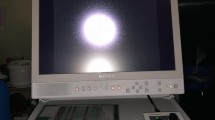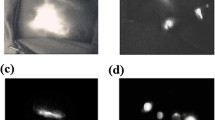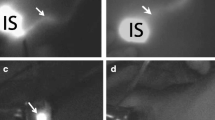Abstract
Near-infrared (NIR) fluorescence imaging using indocyanine green (ICG) has the potential to improve the sentinel lymph node (SLN) procedure by facilitating percutaneous and intraoperative identification of lymphatic channels and SLNs. Previous studies suggested that a dose of 0.62 mg (1.6 mL of 0.5 mM) ICG is optimal for SLN mapping in breast cancer. The aim of this study was to evaluate the diagnostic accuracy of NIR fluorescence for SLN mapping in breast cancer patients when used in conjunction with conventional techniques. Study subjects were 95 breast cancer patients planning to undergo SLN procedure at either the Dana-Farber/Harvard Cancer Center (Boston, MA, USA) or the Leiden University Medical Center (Leiden, the Netherlands) between July 2010 and January 2013. Subjects underwent the standard-of-care SLN procedure at each institution using 99Technetium-colloid in all subjects and patent blue in 27 (28 %) of the subjects. NIR fluorescence-guided SLN detection was performed using the Mini-FLARE imaging system. SLN identification was successful in 94 of 95 subjects (99 %) using NIR fluorescence imaging or a combination of both NIR fluorescence imaging and radioactive guidance. In 2 of 95 subjects, radioactive guidance was necessary for initial in vivo identification of SLNs. In 1 of 95 subjects, NIR fluorescence was necessary for initial in vivo identification of SLNs. A total of 177 SLNs (mean 1.9, range 1–5) were resected: 100 % NIR fluorescent, 88 % radioactive, and 78 % (of 40 nodes) blue. In 2 of 95 subjects (2.1 %), SLNs-containing macrometastases were found only by NIR fluorescence, and in one patient this led to upstaging to N1. This study demonstrates the safe and accurate application of NIR fluorescence imaging for the identification of SLNs in breast cancer patients, but calls into question what technique should be used as the gold standard in future studies.



Similar content being viewed by others
References
Cox CE, Pendas S, Cox JM, Joseph E, Shons AR, Yeatman T, Ku NN, Lyman GH, Berman C, Haddad F, Reintgen DS (1998) Guidelines for sentinel node biopsy and lymphatic mapping of patients with breast cancer. Ann Surg 227:645–651
Goyal A, Newcombe RG, Chhabra A, Mansel RE (2006) Factors affecting failed localisation and false-negative rates of sentinel node biopsy in breast cancer: results of the ALMANAC validation phase. Breast Cancer Res Treat 99:203–208
Krag DN, Anderson SJ, Julian TB, Brown AM, Harlow SP, Ashikaga T, Weaver DL, Miller BJ, Jalovec LM, Frazier TG, Noyes RD, Robidoux A, Scarth HM, Mammolito DM, McCready DR, Mamounas EP, Costantino JP, Wolmark N (2007) Technical outcomes of sentinel-lymph-node resection and conventional axillary-lymph-node dissection in patients with clinically node-negative breast cancer: results from the NSABP B-32 randomised phase III trial. Lancet Oncol 8:881–888
Zavagno G, De Salvo GL, Scalco G, Bozza F, Barutta L, Del BP, Renier M, Racano C, Carraro P, Nitti D (2008) A randomized clinical trial on sentinel lymph node biopsy versus axillary lymph node dissection in breast cancer: results of the Sentinella/GIVOM trial. Ann Surg 247:207–213
Straver ME, Meijnen P, van Tienhoven G, van de Velde CJ, Mansel RE, Bogaerts J, Duez N, Cataliotti L, Klinkenbijl JH, Westenberg HA, van der Mijle H, Snoj M, Hurkmans C, Rutgers EJ (2010) Sentinel node identification rate and nodal involvement in the EORTC 10981-22023 AMAROS trial. Ann Surg Oncol 17:1854–1861
Mansel RE, MacNeill F, Horgan K, Goyal A, Britten A, Townson J, Clarke D, Newcombe RG, Keshtgar M, Kissin M, Layer G, Hilson A, Ell P, Wishart G, Brown D, West N (2013) Results of a national training programme in sentinel lymph node biopsy for breast cancer. Br J Surg 100:654–661
Reyes F, Noelck M, Valentino C, Grasso-Lebeau L, Lang J (2010) Complications of methylene blue dye in breast surgery: case reports and review of the literature. J Cancer 2:20–25
Zakaria S, Hoskin TL, Degnim AC (2008) Safety and technical success of methylene blue dye for lymphatic mapping in breast cancer. Am J Surg 196:228–233
Pesek S, Ashikaga T, Krag LE, Krag D (2012) The false-negative rate of sentinel node biopsy in patients with breast cancer: a meta-analysis. World J Surg 36:2239–2251
Hojo T, Nagao T, Kikuyama M, Akashi S, Kinoshita T (2010) Evaluation of sentinel node biopsy by combined fluorescent and dye method and lymph flow for breast cancer. Breast 19:210–213
Tagaya N, Aoyagi H, Nakagawa A, Abe A, Iwasaki Y, Tachibana M, Kubota K (2011) A novel approach for sentinel lymph node identification using fluorescence imaging and image overlay navigation surgery in patients with breast cancer. World J Surg 35:154–158
Sugie T, Sawada T, Tagaya N, Kinoshita T, Yamagami K, Suwa H, Ikeda T, Yoshimura K, Niimi M, Shimizu A, Toi M (2013) Comparison of the indocyanine green fluorescence and blue dye methods in detection of sentinel lymph nodes in early-stage breast cancer. Ann Surg Oncol 20:2213–2218
Takeuchi M, Sugie T, Abdelazeem K, Kato H, Shinkura N, Takada M, Yamashiro H, Ueno T, Toi M (2012) Lymphatic mapping with fluorescence navigation using indocyanine green and axillary surgery in patients with primary breast cancer. Breast J 18:535–541
Hirano A, Kamimura M, Ogura K, Kim N, Hattori A, Setoguchi Y, Okubo F, Inoue H, Miyamoto R, Kinoshita J, Fujibayashi M, Shimizu T (2012) A comparison of indocyanine green fluorescence imaging plus blue dye and blue dye alone for sentinel node navigation surgery in breast cancer patients. Ann Surg Oncol 19:4112–4116
Wishart GC, Loh SW, Jones L, Benson JR (2012) A feasibility study (ICG-10) of indocyanine green (ICG) fluorescence mapping for sentinel lymph node detection in early breast cancer. Eur J Surg Oncol 38:651–656
Aoyama K, Kamio T, Ohchi T, Nishizawa M, Kameoka S (2011) Sentinel lymph node biopsy for breast cancer patients using fluorescence navigation with indocyanine green. World J Surg Oncol 9:157
Abe H, Mori T, Umeda T, Tanaka M, Kawai Y, Shimizu T, Cho H, Kubota Y, Kurumi Y, Tani T (2011) Indocyanine green fluorescence imaging system for sentinel lymph node biopsies in early breast cancer patients. Surg Today 41:197–202
Kitai T, Kawashima M (2011) Transcutaneous detection and direct approach to the sentinel node using axillary compression technique in ICG fluorescence-navigated sentinel node biopsy for breast cancer. Breast Cancer 19:343–348
van der Vorst JR, Schaafsma BE, Verbeek FP, Hutteman M, Mieog JS, Lowik CW, Liefers GJ, Frangioni JV, van de Velde CJ, Vahrmeijer AL (2012) Randomized comparison of near-infrared fluorescence imaging using indocyanine green and 99mTechnetium with or without patent blue for the sentinel lymph node procedure in breast cancer patients. Ann Surg Oncol 19:4104–4111
Schaafsma BE, Verbeek FP, Rietbergen DD, van der Hiel B, van der Vorst JR, Liefers GJ, Frangioni JV, van de Velde CJ, van Leeuwen FW, Vahrmeijer AL (2013) Clinical trial of combined radio- and fluorescence-guided sentinel lymph node biopsy in breast cancer. Br J Surg 100:1037–1044
Mieog JS, Troyan SL, Hutteman M, Donohoe KJ, van der Vorst JR, Stockdale A, Liefers GJ, Choi HS, Gibbs-Strauss SL, Putter H, Gioux S, Kuppen PJ, Ashitate Y, Lowik CW, Smit VT, Oketokoun R, Ngo LH, van de Velde CJ, Frangioni JV, Vahrmeijer AL (2011) Toward optimization of imaging system and lymphatic tracer for near-infrared fluorescent sentinel lymph node mapping in breast cancer. Ann Surg Oncol 18:2483–2491
Hutteman M, Mieog JS, van der Vorst JR, Liefers GJ, Putter H, Lowik CW, Frangioni JV, van de Velde CJ, Vahrmeijer AL (2011) Randomized, double-blind comparison of indocyanine green with or without albumin premixing for near-infrared fluorescence imaging of sentinel lymph nodes in breast cancer patients. Breast Cancer Res Treat 127:163–170
Hirche C, Murawa D, Mohr Z, Kneif S, Hunerbein M (2010) ICG fluorescence-guided sentinel node biopsy for axillary nodal staging in breast cancer. Breast Cancer Res Treat 121:373–378
Frangioni JV (2003) In vivo near-infrared fluorescence imaging. Curr Opin Chem Biol 7:626–634
Vahrmeijer AL, Hutteman M, van der Vorst JR, van de Velde CJ, Frangioni JV (2013) Image-guided cancer surgery using near-infrared fluorescence. Nat Rev Clin Oncol 10(9):507–518
Fujisawa Y, Nakamura Y, Kawachi Y, Otsuka F (2012) Indocyanine green fluorescence-navigated sentinel node biopsy showed higher sensitivity than the radioisotope or blue dye method, which may help to reduce false-negative cases in skin cancer. J Surg Oncol 106:41–45
Blum KS, Proulx ST, Luciani P, Leroux JC, Detmar M (2013) Dynamics of lymphatic regeneration and flow patterns after lymph node dissection. Breast Cancer Res Treat 139:81–86
Gioux S, Choi HS, Frangioni JV (2010) Image-guided surgery using invisible near-infrared light: fundamentals of clinical translation. Mol Imaging 9:237–255
Kiluk JV, Ly QP, Santillan AA, Meade T, Ramos D, Reintgen DS, Dessureault S, Davis M, Shamehdi C, Cox CE (2010) Erratum to: axillary recurrence rate following negative sentinel node biopsy for invasive breast cancer: long-term follow-up. Ann Surg Oncol 17:552–557
Benya R, Quintana J, Brundage B (1989) Adverse reactions to indocyanine green: a case report and a review of the literature. Cathet Cardiovasc Diagn 17:231–233
Bezu C, Coutant C, Salengro A, Darai E, Rouzier R, Uzan S (2011) Anaphylactic response to blue dye during sentinel lymph node biopsy. Surg Oncol 20:e55–e59
Alford R, Simpson HM, Duberman J, Hill GC, Ogawa M, Regino C, Kobayashi H, Choyke PL (2009) Toxicity of organic fluorophores used in molecular imaging: literature review. Mol Imaging 8:341–354
Ohnishi S, Lomnes SJ, Laurence RG, Gogbashian A, Mariani G, Frangioni JV (2005) Organic alternatives to quantum dots for intraoperative near-infrared fluorescent sentinel lymph node mapping. Mol Imaging 4:172–181
Rajagopalan R, Uetrecht P, Bugaj JE, Achilefu SA, Dorshow RB (2000) Stabilization of the optical tracer agent indocyanine green using noncovalent interactions. Photochem Photobiol 71:347–350
Tagaya N, Nakagawa A, Abe A, Iwasaki Y, Kubota K (2010) Non-invasive identification of sentinel lymph nodes using indocyanine green fluorescence imaging in patients with breast cancer. Open Surg Oncol J 2:71–74
Acknowledgments
The authors thank Alan Stockdale, Dr. Vivek Venugopal, Florin Neacsu, Frank W. Kettenring, Dr. Yoshitomo Ashitate, Dr. Summer Gibbs, and Yang (Allison) Xie for operation of the Mini-FLARE imaging system, and David J. Burrington, Jr. for editing. F.P.R. Verbeek’s travel to Boston for completion of the trials was sponsored by the Leiden University Fund/Piso Kuperus. J.S.D. Mieog is a MD-medical research trainee funded by The Netherlands Organization for Health Research and Development (Grant No. 92003526). This study was performed within the framework of the Centre for Translational Molecular Medicine, project MUSIS (grant 03O-202), and was funded by the Nuts Ohra Fund, Dutch Cancer Society grant UL2010-4732 and National Institutes of Health grants R21-CA-130297 and R01-CA-115296. The content is solely the responsibility of the authors and does not necessarily represent the official views of the National Institutes of Health.
Conflict of interest
Floris P.R. Verbeek, Susan L. Troyan, J. Sven D. Mieog, Gerrit-Jan Liefers, Lorissa A. Moffitt, Mireille Rosenberg, Judith Hirshfield-Bartek, Sylvain Gioux, Cornelis J.H. van de Velde, Alexander L. Vahrmeijer: none. John V. Frangioni: FLARE™ technology is owned by the Beth Israel Deaconess Medical Center, a teaching hospital of Harvard Medical School. Dr. Frangioni has started three for-profit companies, Curadel, Curadel ResVet Imaging, and Curadel Surgical Innovations, which has optioned FLARE™ technology for potential licensing from Beth Israel Deaconess Medical Center.
Ethical standards
This study was approved separately by the Medical Ethics Committees of the Dana-Farber/Harvard Cancer Center (Boston, MA, USA) and the Leiden University Medical Center (Leiden, The Netherlands) and performed in accordance with the ethical standards of the Helsinki Declaration of 1975. All subjects gave informed consent and were anonymized.
Author information
Authors and Affiliations
Corresponding author
Additional information
Clinical Trial Registrations: National Clinical Trial NCT01468649 and the Netherlands Trial Register NTR2084.
Floris P.R. Verbeek and Susan L. Troyan contributed equally to the study and share first authorship.
Rights and permissions
About this article
Cite this article
Verbeek, F.P.R., Troyan, S.L., Mieog, J.S.D. et al. Near-infrared fluorescence sentinel lymph node mapping in breast cancer: a multicenter experience. Breast Cancer Res Treat 143, 333–342 (2014). https://doi.org/10.1007/s10549-013-2802-9
Received:
Accepted:
Published:
Issue Date:
DOI: https://doi.org/10.1007/s10549-013-2802-9




